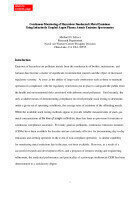Air Monitoring
Continuous Monitoring of Hazardous Smokestack Metal Emissions Using Inductively Coupled Argon Plasma Atomic Emission Spectrometry
Oct 06 2014
Author: Michael D Seltzer on behalf of CEM
Introduction
Emission of hazardous air pollutant metals from the smokestacks of boilers, incinerators, and furnaces has become a matter of significant environmental concern and the object of increased regulatory scrutiny. At issue, is the ability of large-scale combustors such as these to maintain operation in compliance with the regulatory restrictions put in place to safeguard the public from the health and environmental risks associated with airborne metal pollutants. Until recently, the only available means of demonstrating compliance involved periodic stack testing to determine, under a given set of operating conditions, the average rates of emission of the offending metals. While the available stack testing methods appear to provide reliable measurements of stack gas metal concentrations at the time of sample collection, there has been no provision for interim or continuous compliance assurance. For many gaseous pollutants, continuous emissions monitors (CEMs) have been available for decades and are extremely effective for documenting day-to-day emissions and alerting operators in the event of non-compliant operation. A similar capability for monitoring metal emissions has in the past, not been available. However, as a result of a successful research and development effort, and a program of iterative testing and engineering refinement, the analytical performance and practicality of a prototype multimetals CEM has been demonstrated to a satisfactory degree.
The technology in question was developed as a result of a collaboration between a U.S. Navy laboratory and the U.S. Army ordnance demilitarization community. While the original intent of this system was to provide compliance assurance monitoring and to facilitate process control for numerous munitions deactivation furnaces, the technology has proven to be extremely versatile and has demonstrated operational compatibility with other large-scale combustors such as hazardous waste incinerators and coal-fired boilers. The multimetals continuous emissions monitor, known as the TraceAIR, is capable of rapid and simultaneous detection of all 14 metals designated as hazardous air pollutants by the U.S. EPA, plus virtually any metal in the chemical periodic table. Detection sensitivity is superior to all competing technologies and is more than adequate to fulfill compliance assurance monitoring requirements.
Specific details of the design and operation of the TraceAIR multimetals CEM can be found elsewhere [1], but are summarized in the present paper in order to include a number of recentlyimplemented engineering refinements. The system, as presently configured, continuously extracts a representative stream of stack gas using a revolutionary shrouded probe design [2] and transports that stream through a heated conduit to the elemental analyzer, in this case, an inductively coupled argon plasma spectrometer. A patented sampling interface [1,3] introduces precise aliquots of the sample stack gas into the argon plasma at approximately 63 second intervals. For each individual aliquot, concentration measurements are made for all metals simultaneously, using a technique called atomic emission spectrometry. Operation of the entire system, including calibration and quality control procedures, is executed automatically under computer control.
While the potential of the multimetals CEM for providing compliance assurance has been clearly evident for some time, demonstrating the accuracy capabilities of this system has been problematic. The present size and complexity of the ICAP elemental analyzer used in this prototype system have prohibited the convenient and desirable location of the analyzer immediately adjacent to the smokestack. Therefore, as a matter of necessity, the technique has relied to a large extent on the pneumatic transport of extracted gases and entrained particulate matter from the stack to the analyzer. This feature, as originally configured and practiced, proved to be a considerable liability, but has since performed more satisfactorily as a result of several refinements.
The results of preliminary performance testing of the TraceAIR multimetals CEM revealed a significant measurement bias that suggested possible problems concerning sample transport inefficiency. Subsequent systematic investigation of aerosol deposition losses in the sample extraction and transport components indicated the existence of serious operational deficiencies to which the noted measurement bias could be attributed with a high degree of certainty. In order to resolve these deficiencies, a detailed assessment of the existing sample extraction and transport hardware and methodology was undertaken, involving the use of a valuable computational tool for modeling aerosol deposition losses in sampling probes and conduits [4]. This approach not only provided theoretical evidence to corroborate the inadequate performance of the existing sampling hardware and methodology, but also proved useful in facilitating the design of an improved sampling system. The present paper discusses the design of the improved sampling system and its integration into the TraceAIR multimetals CEM system, and the results of initial field evaluations.
Digital Edition
IET 34.2 March 2024
April 2024
Gas Detection - Biogas batch fermentation system for laboratory use with automatic gas analysis in real time Water/Wastewater - Upcycling sensors for sustainable nature management - Prist...
View all digital editions
Events
Apr 22 2024 Hannover, Germany
Apr 22 2024 Marrakech, Morroco
Apr 23 2024 Kuala Lumpur, Malaysia
Apr 23 2024 Kintex, South Korea
Apr 23 2024 Edmonton, AB, Canada















